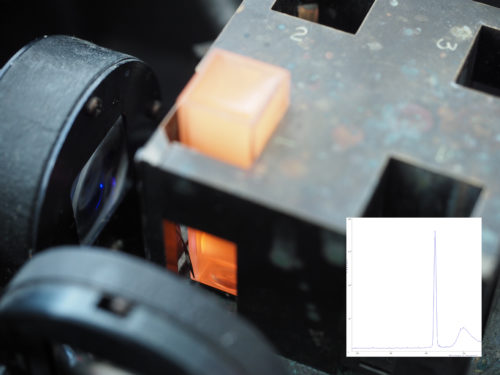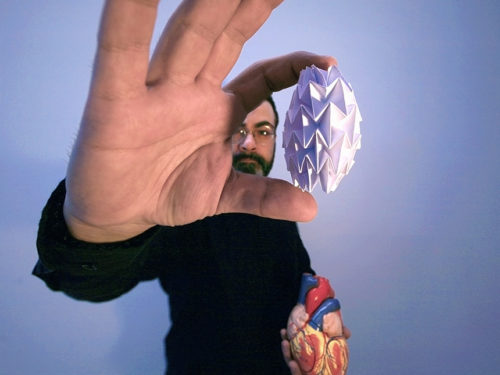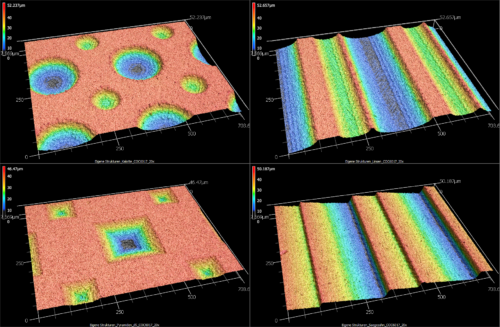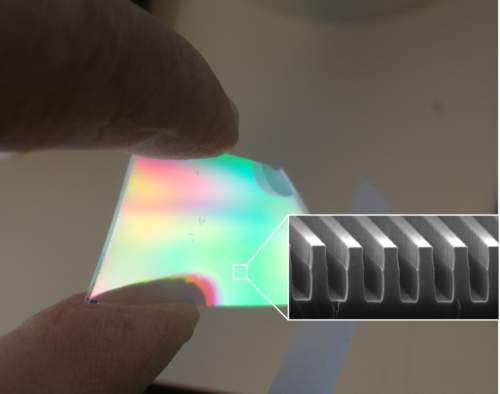Argovia Projects 2019
The following projects started in 2019.
| PROJECT | PROJECT LEADER | COLLABORATORS |
|---|---|---|
| 14.04 DeePest – A detector for pesticides in drinking water | Prof. Dr. Joris Pascal (FHNW Muttenz) | Prof. Dr. Patrick Shahgaldian (FHNW Muttenz) Prof. Dr. Ernest Weingartner (FHNW Windisch) Dr. Daniel Matter (Mems AG, Birmenstorf) |
| 14.07 KOKORO – Origami Heart Model Based on Nano-Patterned Paper Scaffold for Directed Cardiac Tissue Engineering | Dr. Maurizio Rosario Gullo (FHNW Muttenz) | Dr. Joachim Köser (FHNW Muttenz) Dr. Andrea Banfi (Universität Basel DBM) Dr. Anna Marsano (Universität Basel DBM) Dr. Joachim Schoelkopf(Omya International AG, Oftringen) |
| 14.08 LASTRUPOL – Laser-based sub-micron structuring of polymers for advanced origination of micro-optics for physical document security applications | Prof. Dr. Per Magnus Kristiansen (FHNW Windisch) | Prof. Dr. Ronald Holtz (FHNW Windisch) Dr. Helmut Schift (PSI) Dr. Christian Sailer (Gemalto AG, Aarau) |
| 14.13 NCT Nano – Novel Cancer-Targeted Nanoparticles | Dr. Maya Zigler(TargImmune Therapeutics, Basel) | Prof. Dr. Cornelia Palivan (Universität Basel, Dept. Chemie) Dr. Ioana Craciun (Universität Basel, Dept. Chemie) Prof. Dr. Yaakov Benenson (ETH D-BSSE) |
| 14.15 PERIONANO –Nano2: A bioresponsive nano-in-nano composite for drug delivery and tissue regeneration in peri-implantitis | Franziska Koch (FHNW Muttenz) | Prof. Dr. Uwe Pieles (FHNW Muttenz) Prof. Dr. Oliver Germershaus (FHNW Muttenz) Michael Hug (Credentis AG, Windisch) Dr. Stefan Stübinger (Universität Basel, HFZ) |
| 14.19 UltraNanoGRACO – Customized, nanostructured grating compressors for high repetition rate ultrafast lasers | Guillaume Basset (CSEM) Dr. Bojan Resan (FHNW Windisch) Dr. Florian Emaury (Menhir Photonics AG, Basel) | |
14.04 DeePest - First concentrated, then analyzed – Nano Argovia project DeePest researchers are developing a portable system for drinking water analysis
In the Nano Argovia project DeePest, scientists from the Schools of Life Sciences and Engineering at the University of Applied Sciences Northwestern Switzerland (FHNW) are working alongside industry partner Mems AG (Birmenstorf) to develop a fully automatic sensor for detecting pesticides in drinking water. The system is intended to offer a cost-effective extension for existing analysis methods and to continuously detect the presence of a wide range of pesticides in drinking water systems.
Two different sensors
In the first step, the pesticides are concentrated by several orders of magnitude so that, in the subsequent analysis, the researchers can use cost-effective methods whose sensitivity is tailored to the expected substrate concentrations. Working under project leader Professor Dr. Joris Pascal (FHNW), the interdisciplinary team bases its analysis on two different sensors, which exploit different physical properties and can therefore detect different classes of substance.
Initially, the scientists are focusing their efforts on detecting the pesticides glyphosate, atrazine and naphthalene. They are studying various nanostructured plastics that could be used to accumulate specific pesticides in a filter system. In parallel, they are developing cost-effective sensors that detect the presence of the three aforementioned pesticides.
Extension of existing systems
If the development process is a success, it will also be easy to extend the system to other classes of pollutant by fitting the filter cartridges with different absorbent plastics. The device could then conceivably be integrated into the drinking water cycle to ensure continuous monitoring.
"We are optimistic that we can expand our product range with the Nano Argovia project DeePest and provide a cheap, fully automatic pollutant sensor to monitor the drinking water cycle."
Dr. Daniel Matter, Mems AG (Birmenstorf AG)
Further information:
School of Life Sciences (FHNW)
https://www.fhnw.ch/de/die-fhnw/hochschulen/lifesciences
University of Basel DBM
https://biomedizin.unibas.ch/en/home/
14.07 KOKORO - Creating a heart model inspired by origami – In the Nano Argovia project KOKORO, scientists are using nanostructured cellulose as a scaffold for cell cultures
In the Nano Argovia project KOKORO (Japanese for “heart”), a team of researchers from the School of Life Sciences at the University of Applied Sciences Northwestern Switzerland (FHNW), the Department of Biomedicine (DBM) at the University of Basel, and Omya International AG are developing a novel, three-dimensional heart model.
Cellulose as cell culture scaffold
The team led by Dr. Joachim Schoelkopf (Omya) is developing a suitable cellulose paper whose nanostructures provide an ideal culture scaffold for myocardial cells. Using a 3D bioprinting process, the research group working under Dr. Maurizio Gullo (FHNW) and Dr. Joachim Köser (FHNW) applies thin coatings of myocardial cells onto a cellulose layer and thereby build the cardiac tissue. The research group led by Dr. Andrea Banfi (DBM) develops a vascular cell network which will ensure an optimal nutrient supply of the cardiac tissue.
The miniaturized artificial heart model is then created by folding the resulting tissue layers similar to paper origami. In a custom bioreactor developed by the research group of Dr. Anna Marsano (DBM), the heart model is cultured while being mechanically and electrically stimulated. Such physiological stimuli are similar to those experienced by native cardiac tissue and will help to achieve optimum tissue maturation before the heart models undergo in-depth characterization and physiological assessment.
An ideal way to test therapies
Using the model, the interdisciplinary team of researchers working under project leader Maurizio Gullo intend to investigate various tissue parameters, as well as the contractility, volume changes and functionality of the “paper heart.” An artificial heart model of this kind provides ideal means to test therapeutic approaches for treating heart strokes and other forms of cardiovascular disease. In future, the project findings will doubtlessly serve as base for developing tissue patches aimed for cardiac tissue regeneration.
Suitable cell culture scaffold
“The folding technique is an elegant way to overcome the complexity of the 3D bioprinting process as well as to enable the manufacturing of larger sample quantities. Inspired by origami, the cellulose-based cell culture scaffold enables the creation of 3D heart models,” explains Maurizio Gullo.
"Cellulose-based fiber networks are increasingly being used as cell cultures scaffolds. Careful selection of the fiber dimensions and their spatial arrangement facilitates the building of artificial tissues."
Dr. Joachim Schoelkopf, Head of Basic Research at Omya International AG (Oftringen, AG)
Further information:
School of Life Sciences (FHNW)
https://www.fhnw.ch/de/die-fhnw/hochschulen/lifesciences
Department of Biomedicine, University of Basel
https://biomedizin.unibas.ch/en/
Omya International AG
https://www.omya.com/
14.08 LASTRUPOL - Tiny structures for security – Nano Argovia project LASTRUPOL researchers are developing a new fabrication process for security features
In the Nano Argovia project LASTRUPOL, researchers from the FHNW School of Engineering, the Paul Scherrer Institute (PSI) and the company Gemalto AG (Aarau) are working together to develop a new fabrication process for security features on identity documents. The aim of the project is to produce three-dimensional optical structures with high precision and surface quality using the most economical process possible.
First structured, then smoothed
The team working under project leader Professor Dr. Per Magnus Kristiansen begins by using ultrashort laser pulses to remove material from a plastic surface in a targeted manner. Once engraved with these microscale structures, the surface is then smoothed to a roughness of less than 100 nanometers in a process that leaves the fine structures unaffected.
To do this, the scientists use a contactless method that was investigated in the Nano Argovia project SurfFlow and that reduces the glass transition temperature (the temperature at which the polymers change from a solid state into a thick molten mass) on the surface. If the sample is heated gently following this preliminary treatment, only the treated uppermost layers reach their glass transition temperature and become smooth, while the underlying structure and deeper layers remain virtually unchanged. In the LASTRUPOL project, this method must now be adapted to new materials and larger structures – an apparently simple proposition that actually presents a considerable challenge.
The combination of the two techniques should then lead to the production of templates that allow various security features to be reproduced easily. To begin with, the researchers are applying this method to two different types of security features: Firstly, to optical features produced by differences in diffraction on the structures; and secondly, to those created by tiny lenticular and spherical plastic lenses.
New technologies are key
“We’re a leading company in the area of digital and physical identity solutions,” explains Dr. Christian Sailer, Head of Physical Document Security R&D Switzerland at the project’s industry partner, Gemalto AG. “It’s vital for us to invest in new technologies aimed at producing security products in order to maintain this leading position. The Nano Argovia project LASTRUPOL is an excellent opportunity to benefit from the expertise of plastics processing specialists at the School of Engineering and the PSI.”
"The Nano Argovia project LASTRUPOL is an excellent opportunity to benefit from the expertise of plastics processing specialists at the School of Engineering and the PSI."
Dr. Christian Sailer, Gemalto AG (Aarau, AG)
Further information:
School of Engineering (FHNW)
https://www.fhnw.ch/de/die-fhnw/hochschulen/ht
Paul Scherrer Institute
https://www.psi.ch/en
Gemalto AG
https://www.gemalto.com
14.13 NCT Nano - Using nanoparticles to defeat cancer – In the Nano Argovia project NCT Nano, researchers are exploring a new immunotherapy approach to cancer treatment
In the Nano Argovia project NCT Nano, three interdisciplinary teams are collaborating to characterize a novel, targeted immuno-oncology approach. Scientists from TargImmune Therapeutics (Basel), the Department of Chemistry at the University of Basel, and the Department of Biosystems Science and Engineering at ETH Zurich in Basel (D-BSSE) are studying nanoparticles that smuggle a specific cargo into cancer cells. This cargo concurrently triggers targeted cancer cell killing and an anti-tumor immune response, destroying the tumors. In the Nano Argovia project NCT Nano, the researchers are identifying key parameters that are necessary to support the development of TargImmune’s novel therapeutic for the clinic.
Significant advances have been made in the field of cancer therapy in the past few years. However, cancer remains a major contributor to morbidity and mortality worldwide. Numerous treatment modalities have been developed and approved for the treatment of solid tumors including small molecules, antibodies and cell-based therapies. However, due to tumor heterogeneity as well as suppression of and escape from anti-tumor immune response, resistance to treatments continuously emerges.
More recently, immune-modulatory antibodies have shown significant efficacy in several indications. Nonetheless, only a subset of the patient population is responsive, therefore leaving the majority of patients without an effective treatment.
TargImmune Therapeutics is developing a novel platform technology based on the research from the Hebrew University of Jerusalem. The technology utilizes chemical vectors that selectively enter cancer cells and smuggle in a specific cargo, bringing about cell death and simultaneously triggering an immune response against the tumor.
Safe transport
The cargo is packed with a chemical vector, forming nanoparticles. These nanoparticles should be stable and allow safe delivery of the cargo in patients, while ensuring that the cargo is not broken down by enzymes and reaches the targeted cancer cells without affecting healthy non-cancerous cells. The factors that affect nanoparticle stability and contribute to the efficacy of the treatment are being studied and optimized at the laboratory of Professor Cornelia Palivan from the Department of Chemistry at the University of Basel.
Various parameters must be identified
TargImmune’s technology has proven highly effective in several mouse models. However, before the drugs can be used in human clinical trials, it is necessary to identify the optimal conditions for drug formulation. To do so, the Palivan group will test a range of key parameters relating to the nanoparticle’s stability, including physico-chemical properties, reproducibility and quality control. The Palivan group will also contribute to the understanding of how the particles bind and smuggle the cargo into the targeted cells, using various microscopy techniques.
The group led by Professor Yaakov (Kobi) Benenson from the D-BSSE will use next generation sequencing to investigate the activity of the novel nanoparticles in a variety of cell lines, as part of this interdisciplinary collaboration.
"We’re optimistic that our approach can help countless patients around the world in their fight against cancer. The Nano Argovia project allows us to gain important insights that will contribute to the development of our drugs to the clinic."
Dr. Maya Zigler, project leader of NCT Nano and head of research at TargImmune Therapeutics
Further information:
Department of Chemistry, University of Basel
https://chemie.unibas.ch/de/home/
D-BSSE, ETHZ in Basel
https://bsse.ethz.ch
TargImmune Therapeutics
https://www.targimmune.com/
14.15 PERIONANO - Two effects with a single product – In the Nano Argovia project PERIONANO, researchers are combating inflammation around dental implants and supporting tissue regeneration
In the Nano Argovia project PERIONANO, scientists from the FHNW School of Life Sciences and the Hightech Research Center of Cranio-Maxillofacial Surgery
(University of Basel) are working with industry partner credentis AG (Windisch, Aargau) to investigate a new approach for the treatment of inflammation around dental implants (peri-implantitis). The scientists are developing an easy-to-use system based on a peptide hydrogel with embedded particles that successively release antimicrobial active substances and also promote regeneration.
In many cases, dental implants are accompanied by inflammation due to bacterial colonization, resulting in the degradation of surrounding soft tissue and bone (peri-implantitis) and potentially leading to the loss of the implant. Peri-implantitis is usually treated using local or systemic antibiotics, but there is currently no treatment that acts against the bacteria while simultaneously encouraging regeneration of the damaged tissue.
A peptide scaffold
That is precisely the approach adopted by the team working under project leader Franziska Koch from the School of Life Sciences at the University of Applied Sciences and Arts Northwestern Switzerland (FHNW). The scientists begin by using peptides that can form a fibrous network (Figure 1A). Into this network, they then incorporate a variety of particles (Figure 1B) that can release active substances little by little. With this technique, the researchers hope to achieve the localized release of various active substances, which would then combat different pathogenic species of bacteria in their vicinity. The fibrous scaffold of peptides is also intended to promote the regeneration of damaged soft and bony tissue.
Interdisciplinary collaboration
With an interdisciplinary team consisting of Franziska Koch, Professors Uwe Pieles and Oliver Germershaus (both from FHNW), PD Dr. Stefan Stübinger (Hightech Research Center of Cranio-Maxillofacial Surgery, University of Basel) and Michael Hug (credentis AG), the Nano Argovia project brings together partners with very different areas of expertise. Together, they are able to analyze the peptide-particle matrix with regard to active substance release, antimicrobial activity and regenerative potential translating it into a marketable product.
"By participating in the Nano Argovia project PERIONANO, we’re significantly extending our Curolox® Technology. This approach supports our efforts not only to keep teeth healthy but also to take care of implants by successfully treating the inflammation around the implants and by promoting regeneration."
Michael Hug, CTO at credentis AG
Further information:
School of Life Sciences, FHNW
https://www.fhnw.ch/de/die-fhnw/hochschulen/lifesciences
Hightech Research Center HFZ
https://dbe.unibas.ch/en/research/laser-and-robotics/hightech-research-center-hfz/
credentis AG
https://www.credentis.com
14.19 UltraNanoGRACO - Shorter light pulses thanks to nanostructured gratings – The Nano Argovia project UltraNanoGRACO is testing a new type of laser system
In the Nano Argovia project UltraNanoGRACO, a team of researchers from CSEM Muttenz, the University of Applied Sciences and Arts Northwestern Switzerland, and the startup Menhir Photonics AG (Basel) are examining a new type of laser pulse compressor to be combined with an ultrafast laser. The laser system is intended to produce extremely short, high-intensity light pulses.
Amplification required
Ultrafast lasers have many potential applications, ranging from telecommunications through metrology and machining metals to medical engineering. The light pulses from these lasers have a duration of less than 1 picosecond (10-12 seconds). Some applications require the pulses to be amplified. To ensure that excessive pulse intensity does not damage the amplifiers, the light pulses are first stretched and then compressed again once they have passed through the amplifier. The compression quality is a decisive factor for the final length of the pulse and the maximum intensity. These are parameters that have to be optimized for different applications.
Gratings result in superimposition
In the Nano Argovia project UltraNanoGRACO, researchers led by Dr. Fabian Lütolf from CSEM Muttenz are examining a new type of laser pulse compressor for ultrafast lasers that is intended to enable increased intensity. The stretched light pulses pass through the newly developed optical gratings. The gratings cause the wavelengths, which were previously temporally and spatially separated, to be superimposed again and produce a shorter and more intense light pulse.
The compressor studied in the project together with the partners Dr. Bojan Resan (School of Engineering, FHNW) and Dr. Florian Emaury (Menhir Photoics AG) not only individually shortens and intensifies the light pulse, but also meets the requirements for stability and economic viability with an optimized design.
The project partners are testing whether the compressor can be used together with the ultrafast Menhir Photonics laser to reliably generate pulses with wavelengths of 1550 nm that can be used for telecommunications, metrology, and nonlinear optical applications.
"The partners involved in the Nano Argovia project UltraNanoGRACO have the perfect combination of expertise in the design and production of nanostructures and in laser research and development. For Menhir Photonics, the project is an ideal opportunity to conduct a feasibility study."
Dr. Florian Emaury, Managing Director and Co-Founder of Menhir Photonics AG
Further information:
School of Engineering, FHNW
https://www.fhnw.ch/de/die-fhnw/hochschulen/ht
Menhir Photonics
https://menhir-photonics.com





